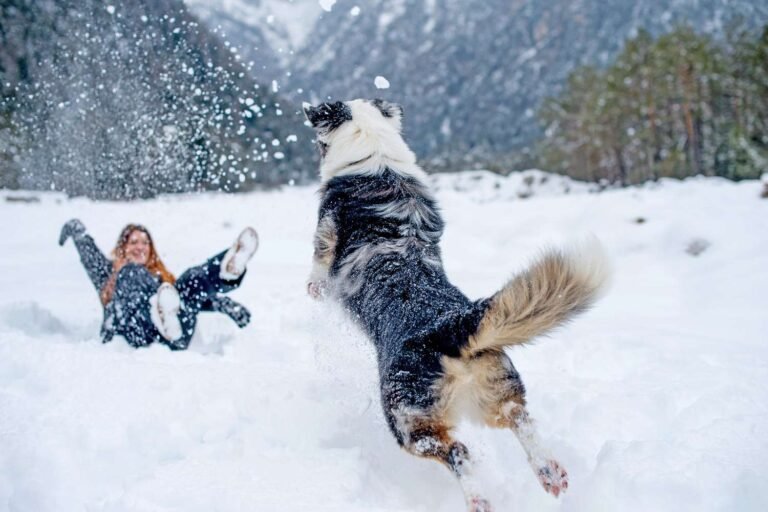There’s no reason for winter to put a damper on your outdoor adventures with your dog. Preparing your furry friend for chilly weather is crucial to ensure their comfort and safety while you both enjoy the beauty of the season. In this guide, you’ll discover practical tips and crucial gear to keep your dog happy and healthy during your winter escapades, so you can create lasting memories together in the snow.
Key Takeaways:
- Dress your dog in appropriate winter gear, such as jackets or booties, to protect them from cold temperatures and ice.
- Limit outdoor time in severe weather and monitor for signs of cold stress while on winter outings.
- Keep your dog’s paws clean and moisturized to prevent cracking and irritation caused by ice and salt.
How to Choose the Right Winter Gear for Your Dog
Choosing the right winter gear for your dog is paramount to ensuring they enjoy the cold weather safely. Look for items that provide warmth without restricting movement, keeping your pup comfortable during outdoor excursions. Consider the climate you live in and your dog’s breed, as this can influence the type of gear needed. Always prioritize quality materials that withstand icy conditions, and don’t forget to check the fit to prevent discomfort. Thou must gear up for an adventure!
Understanding Different Types of Dog Coats
Dog coats come in various styles and materials tailored to specific climates and activities. Options include insulated jackets, waterproof raincoats, and stylish fleece pullovers. Each design serves a unique purpose, ensuring your pup stays warm, dry, and visible during winter outings.
| Coat Type | Description |
| Insulated Jacket | Provides warmth with filling material. |
| Waterproof Coat | Keeps your dog dry in wet conditions. |
| Fleece Pullover | Lightweight layer for moderate warmth. |
| Reflective Gear | Enhances visibility during low-light walks. |
| Boots | Protects paws from cold and ice. |
Selecting Boots for Optimal Paw Protection
Selecting the right boots for your dog is crucial for protecting their paws against harsh winter conditions. Look for waterproof materials and a secure fit to prevent slipping. Insulated and padded options provide added comfort, while non-slip soles ensure stability on icy surfaces. Matching the size and style to your dog’s needs will enhance their winter experience.
Consider the terrain and weather when choosing boots. If your dog frequently walks on salt-treated sidewalks, opt for boots designed to withstand corrosive materials. Start by measuring your dog’s paws to find the right size, and allow them time to adjust to wearing them. Make it a fun experience to encourage future use. Thou shall keep your furry friend’s paws happy and protected this winter!
Tips for Keeping Your Dog Safe in Cold Weather
Keeping your dog safe during winter adventures requires careful planning. Here are some imperative tips to ensure a safe experience:
- Limit outdoor time in extreme cold.
- Use a dog coat or sweater for extra warmth.
- Protect paws with dog booties or paw wax.
- Always check for signs of discomfort or hypothermia.
- Keep your dog leashed in snowy areas to prevent getting lost.
After taking these precautions, your adventures can be enjoyable and safe for both you and your furry friend.
Recognizing the Signs of Hypothermia and Frostbite
Be vigilant for symptoms of hypothermia and frostbite in your dog. Shivering, lethargy, and difficulty walking can indicate hypothermia, while pale skin, cold extremities, and swelling suggest frostbite. If you notice these signs, it is vital to return your dog to a warm environment and seek veterinary assistance immediately.
Hydration and Nutrition Considerations in Winter
In winter, your dog’s hydration and nutrition needs may change. Cold weather often leads to dried air, which can dehydrate your dog. Ensure they have constant access to fresh water, and consider increasing their food intake to provide extra energy for keeping warm.
During winter months, adjusting your dog’s diet becomes important as they may require additional calories to sustain energy levels. Choosing high-quality, nutrient-dense food can aid in maintaining their body temperature, especially after outdoor activities. Hydration is equally key; indoors, moisture levels drop, so encourage your dog to drink more water, perhaps by providing multiple bowls or opting for warm, broth-based hydration options that are more appealing in colder months.
Factors to Consider Before Winter Adventures
Before heading out into the winter wonderland with your dog, several factors can impact your adventure’s safety and enjoyment. Consider the following:
- Your dog’s physical health and fitness level
- The duration and intensity of the outdoor activities
- Weather conditions and their unpredictability
- Location and terrain of your planned adventure
- Gear you have prepared for both you and your dog
Recognizing your dog’s unique needs can significantly enhance your winter outings. For more tips, check out Winter is Coming: How to Prepare Your Dog for Cold Weather Adventures.
Assessing Your Dog’s Breed and Size
Your dog’s breed and size play a significant role in determining their cold tolerance. Larger breeds like Huskies are naturally equipped for frigid temperatures, while smaller dogs may struggle and require additional protection. Assessing the characteristics of your dog, such as coat type and body fat, can guide your preparation and gear choices for winter outings.
Understanding Temperature Limits for Outdoor Activities
Each dog has its unique temperature tolerance, often influenced by breed, health, and coat thickness. Generally, temperatures below 20°F (-6°C) can be risky for smaller or short-haired dogs. Knowing your dog’s limits is necessary to ensure their safety and comfort during winter activities.
Understanding Temperature Limits for Outdoor Activities
| Temperature Range | Recommended Action |
|---|---|
| Above 32°F (0°C) | Safe for most dogs, monitor for signs of cold stress. |
| 20°F to 32°F (-6°C to 0°C) | Use gear for small or short-haired breeds; limit outdoor time. |
| Above 20°F (-6°C) | Short outings for small dogs; consider dog jackets. |
| Below 20°F (-6°C) | Avoid prolonged exposure; ensure extra warmth for all dogs. |
Understanding temperature limits is vital for your dog’s well-being. Always pay attention to your dog’s behavior during outdoor activities; shivering, lifting paws, or reluctance to move can be indicators they are too cold. Ensure you know specific thresholds for your dog’s breed and react accordingly to their signals.
Assessing Your Dog’s Breed and Size
| Breed Type | Cold Weather Adaptation |
|---|---|
| Working Breeds (e.g., Malamutes) | Well-suited for cold temperatures, long outdoor activities. |
| Small Breeds (e.g., Chihuahuas) | Require more protection; sensitive to cold exposures. |
| Short-Haired Breeds (e.g., Beagles) | May need jackets in colder weather; limit exposure time. |
| Older Dogs and Puppies | More susceptible to cold; exercise caution and limit time. |
How to Prepare Your Dog for Winter Excursions
To ensure enjoyable and safe winter outings, you need to prepare your dog adequately. Start with acclimatizing your pet to the colder weather; gradually expose them to lower temperatures to gauge their tolerance. Incorporate short excursions that allow your dog to familiarize themselves with winter conditions. Pay attention to their comfort and adapt plans accordingly, focusing on shorter hikes or play sessions in snow. This will help build both their endurance and confidence for longer adventures ahead.
Building a Winter Training Routine
Creating a winter training routine enhances your dog’s fitness and adaptability to cold weather. Begin with basic obedience commands to keep your dog focused during potentially distracting winter landscapes. Incorporate physical exercises like agility drills or indoor activities to maintain their energy levels. Aim for at least 30 minutes of training and play each day, adjusting intensity and duration based on your dog’s breed and fitness level. This tailored approach sets the stage for enjoyable outdoor winter activities.
Essential Gear Checklist for Winter Outings
A comprehensive gear checklist can elevate your winter excursions. First, invest in a well-fitted, insulated waterproof jacket for your dog to protect them from the elements. Reflective dog collars or harnesses enhance visibility in low-light conditions. Ensure your pet has booties to protect their paws from ice and salt, while bringing along blankets or towels can help warm them up after play. Hydration is key, so pack water and portable bowls to keep your dog hydrated during outdoor activities.
Include extra items such as pet-safe antifreeze and paw balm to protect your dog’s pads from cracking. A first-aid kit specifically tailored for dogs will keep you prepared for any minor injuries. Lastly, bring a whistle and poop bags to maintain cleanliness and ensure a safe, responsible outing. Assessing these importants can prevent inconveniences, allowing you to focus on memorable experiences with your dog in the winter wonderland.
Tips for Post-Adventure Care
After a day of winter fun, tending to your dog’s needs is crucial for their well-being. Here are some key actions to take:
- Check for any signs of frostbite or injury.
- Thoroughly wipe your dog’s paws and legs to remove salt and ice.
- Provide fresh water to prevent dehydration.
- Ensure your dog is dry and warm before heading indoors.
- Watch for any changes in behavior that might indicate discomfort.
Recognizing these signs will help maintain your dog’s health and ensure they’re ready for the next adventure.
Paw Care After Outdoor Activities
After your winter outing, inspect your dog’s paws for cuts, ice buildup, or salt irritation. Use a damp cloth to clean between the toes and pads. Consider applying a paw balm to soothe any irritation and create a protective barrier for future outings. Regularly pamper their paws, especially if snow or ice were prevalent during your adventure.
Warm-Up Routines for Your Dog
Implementing a warm-up routine can help your dog transition from the cold outdoors to the comfort of home. Start by gently massaging their muscles to improve circulation and restore warmth. You can also engage in light indoor play to keep them active without overexerting. These routines not only comfort your dog but also help prevent injuries or stiffness after exposure to cold weather.
How to Create a Safe and Comfortable Home Environment
Creating a safe and comfortable home environment for your dog during winter is imperative. Ensure that your living space is warm, free from drafts, and that your dog has access to dry areas. Install barriers around heat sources and remove any hazardous items that could be a temptation. Regularly check the environment, especially in cold spells, to keep it inviting and secure for your furry friend.
Insulating Your Dog’s Sleeping Area
Insulate your dog’s sleeping area by using thick, cozy bedding and placing it away from cold drafts. A heated blanket designed for pets can also provide extra warmth on particularly chilly nights. Make sure the bed is situated in a quiet, comfortable corner of your home, ensuring your dog feels safe and relaxed while snoozing away the winter days.
Indoor Activities to Keep Your Dog Engaged
Keeping your dog mentally stimulated indoors is vital during the winter months. Activities like interactive toys, puzzle feeders, and scent games can replace outdoor play. Set up obstacle courses using household items or designate play zones for fetch or tug-of-war games. Engaging in training sessions not only provides exercise but also strengthens your bond with your dog.
Consider rotating toys weekly to maintain your dog’s interest and introducing new activities, such as teaching commands or tricks, which can greatly enrich their experience and prevent boredom. Engaging in arts and crafts to create homemade enrichment toys, like treat-dispensing puzzles, can also promote cognitive activity. Incorporating these activities into your routine ensures your dog stays mentally and physically active, even when outdoor adventures are limited.
Final Words
Drawing together all the imperatives for winter adventures, you can ensure your dog stays warm, safe, and happy during colder months. Equip your furry friend with a suitable winter coat, invest in waterproof boots, and always check their paws for ice or snow buildup after walks. Keep your dog hydrated and adjust their diet as necessary to adapt to the colder climate. By taking the right steps, you can both enjoy delightful winter outings, reinforcing the bond you share while ensuring their comfort and well-being in the chilly weather.
Q: How can I keep my dog warm during winter walks?
A: Dress your dog in a weather-appropriate coat, focusing on one that covers the chest and belly. Use booties to protect their paws from ice and salt. Limit exposure time and consider walking during the warmest parts of the day.
Q: What signs indicate my dog is too cold?
A: Look for shivering, reluctance to move, or lifting their paws off the ground. If your dog starts to whine or seeks warm surfaces, it may indicate they’re uncomfortable due to low temperatures.
Q: How should I care for my dog’s paws in winter?
A: Inspect your dog’s paws regularly for cuts, ice buildup, or salt residue. Trim fur between the toes to prevent ice accumulation and apply a paw balm for added protection. Rinse paws after walks to remove any harmful substances.





